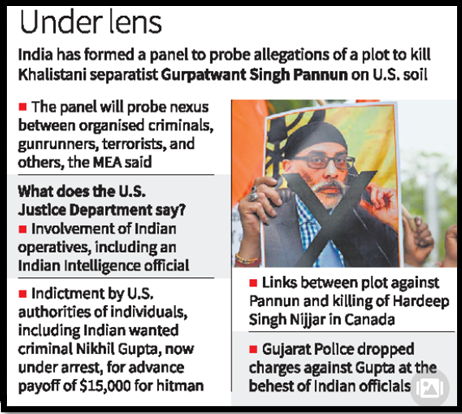US Alleges Indian Official Orchestrated Khalistani Plot
Why in News?
- India forms a high-level committee to investigate U.S. claims of an Indian plot targeting Khalistani activist Gurpatwant Singh Pannun.
- The U.S. alleges an Indian Intelligence official orchestrated the plot.
Source:The hindu
High-Level Probe into U.S. Allegations
- India establishes a committee to investigate U.S. accusations of an assassination plot against Khalistani activist Gurpatwant Singh Pannun.
- The U.S. Department of Justice implicates an unnamed Indian Intelligence official, alleging the masterminding of the plot and connection to the killing of Hardeep Singh Nijjar in Canada.
- Pannun, founder of Sikhs for Justice, faces extradition uncertainties amid escalating tensions between the two nations.
Khalistani Movement
Origin
- The Sikh separatist movement, Khalistan, emerged in 1970s Punjab, fueled by a resurgence of Sikh nationalism and perceived discrimination by the Indian government.
Factors Driving Khalistani Movement
- Sikh Nationalism: 1960s-70s saw a rise in Sikh nationalism due to perceived discrimination.
- Anandpur Sahib Resolution: In 1973, AISSF passed a resolution advocating greater Sikh autonomy.
- Rise of Akali Extremism: Sant Jarnail Singh Bhindranwale’s radical faction emerged, calling for an independent Khalistan and endorsing violence.
Objectives of Khalistani Movement
- Independence: Primary goal is to establish the sovereign Sikh state of Khalistan.
- Preservation of Sikh Identity: Aims to protect Sikh culture and address perceived grievances.
- Promotion of Sikh Values: Advocates justice, equality, and freedom.

 Source:The hindu
Source:The hindu

